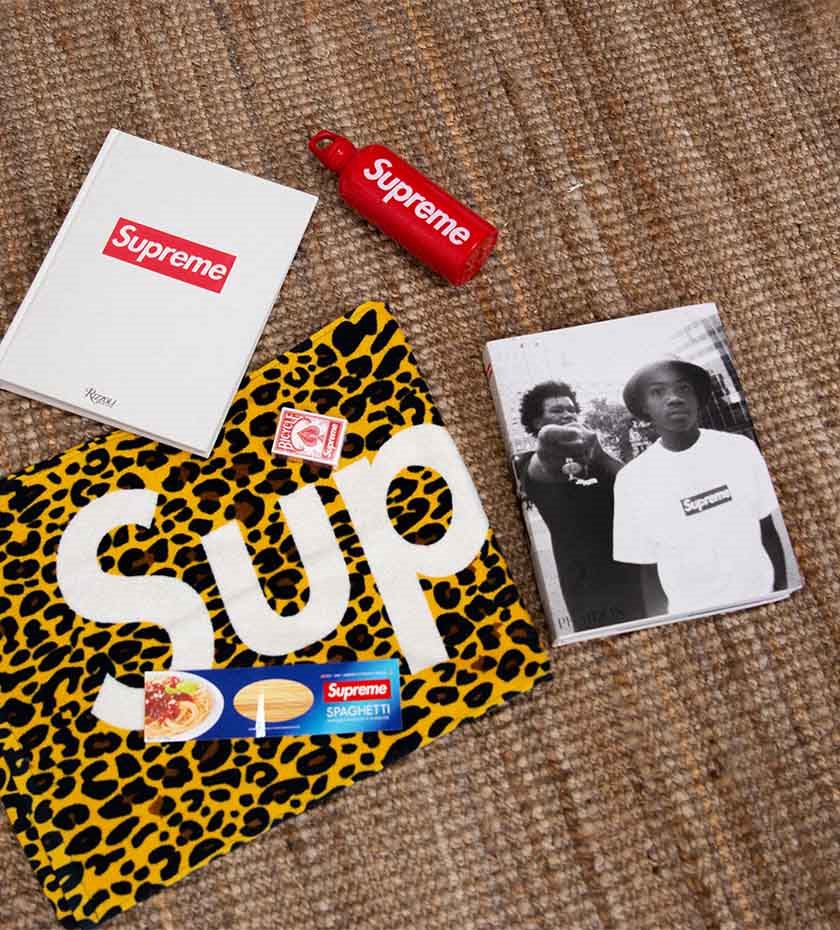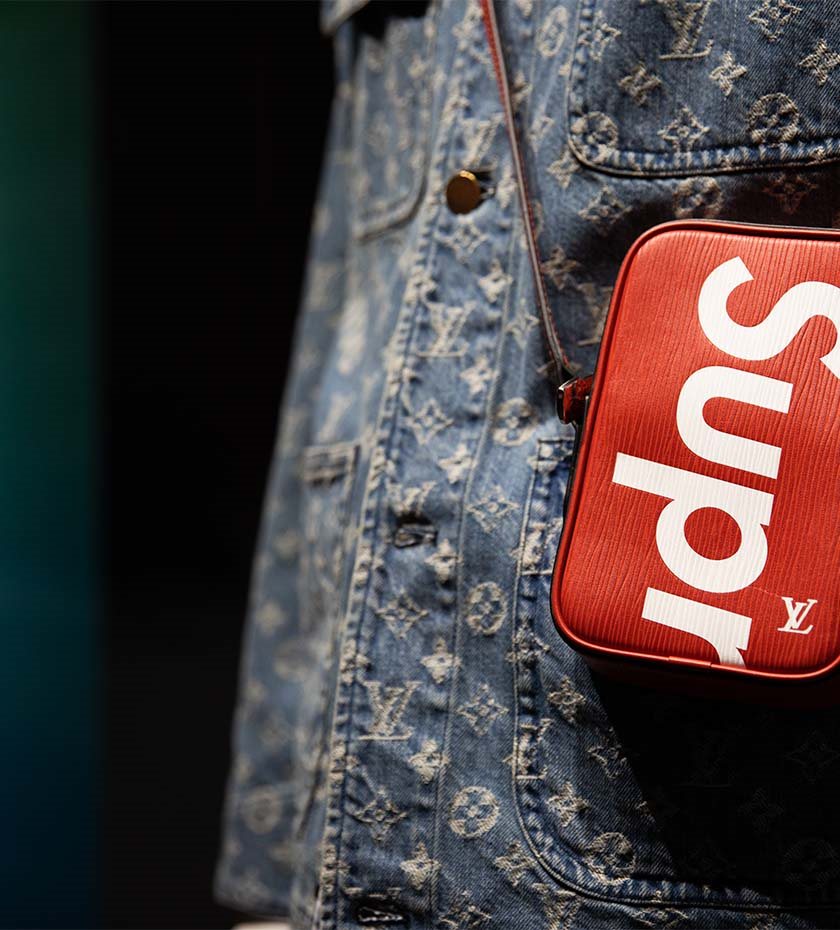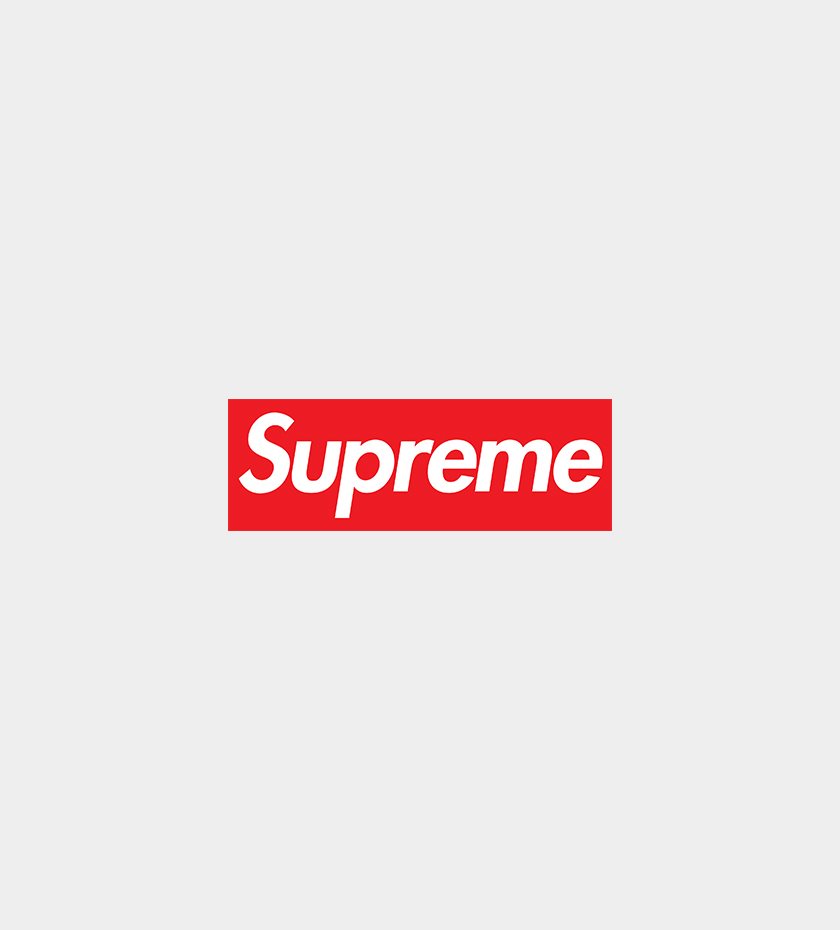Supreme
Without doubt, you know the brand Supreme and Supreme’s products. But do you know the story behind it all? Read on and find out how Supreme was founded, what history and influence the brand has, and how it has grown from a small skate shop in New York City, with the ambition of being the hang-out spot for local youths, to being a world-famous name, to finally being sold for literally billions of dollars.

The Godfather of Streetwear
Supreme was founded by James Jebbia in New York City in April 1994, but it was a multibrand store before it developed into the brand as we know it today.
James Jebbia is not American ¬– originally, he’s from Crawley, West Sussex, in England. As a teenager in the 80s, he was putting in hours at a Duracell factory for extra cash, and the money he made there was spent at a specific London store. The store carried apparel with the right look and the right quality, worn by well-informed and real people.
At 18, James moved from England to SoHo in New York City to work in the Parachute store. After a few years of working at Parachute, he opened the store Union, which primarily sold British brands and streetwear. The business was going well, but when Union started carrying Stüssy it took off. On the side, James helped running a Stüssy shop, but at one point Shawn Stussy (the founder and designer behind Stüssy) decided to pull out. “What do I do now?”, James thought. He had always liked the skate community and culture, as it had an edge and more of a ‘fuck you’-attitude.
So, he decided to open his own skate shop at Lafayette Street in New York City. James used a minimalistic approach when decorating the store, and the Supreme stores still have a minimalistic look, and in the store, there was a monitor with videos constantly playing – everything from Mohammad Ali’s boxing fights to the movie Taxi Driver – to get the passers-by to wake up. Today these monitors can be found in most of the Supreme stores.
The store quickly developed into a spot for the neighborhood’s cool kids and skaters to hang out. James began to put print on some hoodies and caps, and they were well received by the customers. The legendary logo is supposedly made with the regular Word-font Futura. The logo is strongly inspired by Barbara Kruger’s “I Shop Therefore I Am”, where the text is written within a red box.
Business Strategy and Hype
From the very beginning, the store was spartanly decorated and had few items on the shelves in addition to a quite limited inventory. The small inventory was at first due to the fact that James did not have the necessary financial means to purchase large amount of goods. He was also afraid of being stuck with an unsellable stock if it turned out that the customers did not like something. The small numbers helped create an interest, but with the popularity came a new problem. The merchandise sold so quickly, that sometimes people would come into an almost empty store and wonder “is this the store people are talking about?!”. James came up with a solution – each Thursday he released the apparel. By releasing the apparel each Thursday, he managed to keep up the hype, and people understood if something was sold-out and then waited for the next release.
The psychology behind it is that the more a user must interact and work for a specific product, the more alluring the product becomes. It is a strategy that has since been copied by several other brands – an example is the sneaker release hype of Adidas and Nike. It is essentially the same idea. The limited supply of Supreme’s products is creating a lucrative re-selling market. There are examples of Supreme styles increasing thirtyfold in price – an example is the legendary Red Box Logo Tee which originally cost 30 dollars in the store but is now sold for over 900 dollars on the platform StockX.

Other crazy examples of prices that have gone through the roof is the Supreme x Nike Blazer collaboration, which had a retail price of 150 dollars, but skyrocketed to 800 dollars on the re-selling market after pictures of Kanye West wearing them were leaked. An even more crazy increase is the price of the Teal Red Box Logo Hoodie – originally costing 150 dollars in the Supreme stores, it rose to a swindling re-sell sum of 3500 dollars after Tyler the Creator wore one in the “She” music video.
That the apparel is wanted for the apparel itself, or for the massive re-sell value, can be seen in the queues in front of the stores. There have been instances of queues for the actual queue, and you can easily end up standing around for three or four hours before you are let into the store. The police have had to shut down releases, such as the Supreme x Foamposite collaboration, and forced Supreme to sell the apparel online simply due the general risk of the massive amount of people.

Technically, Supreme could increase the prices drastically and make more money, but James refuses to do so – he wants to sell a proper product at a proper price!
James compares the design process with for example music. There will always be critics and people who do not understand why young people can like one thing or the other, but young people, especially skaters, are much more open to new things: music, art, apparel, and so on, and that allows you to design open-mindedly. But James has not been alone in designing the apparel. Several different people have been part of it throughout the ages, and some of them have later gone on to start their own streetwear successes, for example Acapulco Gold, Awake NY, and Noah.
Supreme has always been, and will always be, a skate brand, but it was never designed with the idea in mind that “this is what a skate brand should be offering”. It was rather designed based on inspiration from what was cool on the market, in art, on the music scene, or in the movies. It was designed out of love to the customer and taking into account what they would think was cool. To ensure that the products were good from the very start, James focused a lot on the quality. His strategy was to make clothes that would be at least of the same quality as the customers already got elsewhere, and he cast an eye at brands like Nautica, Polo Ralph Lauren, Levi’s and Carhartt.
To have Supreme were to end up where it is today was not part of the plan. The massive success has been a perfect combination of time and place, luck, and hard work.
In the beginning, James worried about selling merchandise and getting it out into the world. Today he worries about keeping to the exclusive strategy and not over-exposing the brand.
Since 2013, Supreme has worked as a proper fashion company with two yearly collections – spring/summer and fall/winter. They are however still sold according to the strategy of releasing a group of products and styles. Supreme never did much in terms of marketing but have made do with the natural interest and demand their small selection of apparel has created. The paradox of Supreme’s marketing is that the brand is known for not marketing itself. The strength comes from the community that has been created around the brand.
Big in Japan
The first location of a Supreme store outside of the USA was in Japan in 1996, in the district of Harajuku in Tokyo – world famous for its streetstyle. In the area was already an A Bathing Ape store and a Neighborhood store, so Supreme was in good company already from day one.
The Japanese have always been forward-thinking and had a love for streetwear. A Japanese businessman named Ken Omura, who was running the distribution company One Gram, had kept an eye on Supreme for some time and seen the growing Japanese fascination with the American brand. Omura got in contact with James and suggest that he should open a Supreme store in Japan. James realized what he just might be about to create, and he realized it was not just a random skate brand. When Omura in record time opened three Supreme stores in Japan – Tokyo, Osaka, and Fukuoka, between 1996-1998 – James had to scale up the production to keep up with the demand from abroad.
Expanding to Japan has not only made way for a more commercial success for Supreme. It has also created a feature that Supreme is known and loved for today: gadgets. In all collections there are now gadgets in the shape of everything from water bottles to pocketknives to dirt bikes or billiard tables. And it started because the Japanese loves gadgets they can put on display at home or on their desk at work.
The Power of Collaboration
Supreme has always been known for their collaborations, and there has been a fair amount of them by now. Just to name a few, Supreme has collaborated with The North Face, Timberland, Vans, Levi’s, Clark’s, Honda, and Bang & Olufsen. James points to the collaboration with Comme des Garcons in 2012 as a collaboration that helped open a lot of doors and possibilities. The most famous collaboration in recent years is probably the Supreme x Louis Vuitton collaboration from 2017.
From the beginning there has been a close connection between Supreme and the world of art. Therefore, there have also been several collaborations with various artists, among others the renowned artists Jeff Koons and Damien Hirst. If you want a Supreme skate deck designed by either one of them, it can easily cost you 50,000, as they are considered real works of art.
Big business
In 2017, the Carlyle Group invested in Supreme by buying around 50% of the company for 500 million dollars. That created an estimated market value of around 1 billion dollars of Supreme as a company and brand. If that sounds insane, it will become more insane still. Already a few years later, VF Group (the company that owns the likes of The North Face and Vans) purchased Supreme for a staggering sum of 2,1 billion dollars.
The massive success has of course resulted in many attempts to copy Supreme. In Asia, there are fake Supreme products abound, but a crazy example of a copyright lawsuit in Europe is the case between Supreme and the company Supreme Italia. The company copied entire Supreme collections, with the tiny difference that below “Supreme” it said “Italia” in very small print. Supreme won the lawsuit against the company in 2018, but they are supposedly still selling fake products on both the Spanish and Chinese markets. James had probably not considered the massive financial development when he opened the little skate shop in New York and started printing a few t-shirts for fun, but nonetheless he founded and built a world-wide, market-leading, and tendency-steering company – all based on the love for skateboarding.
Currently, Supreme has 14 stores around the world. Four in USA (New York, Brooklyn, San Francisco, Los Angeles), four in Europe (Paris, London, Milano, Berlin) and six in Japan (Harajuku, Shibuya, Nagoya, Daikanyamacho, Osaka, Fukuoka). There are rumors about the opening of a store in the Tower Records building in West Hollywood in Los Angeles soon.
In a GQ interview about the future and Supreme’s development, James says: “We can just do what we’ve always done, which is try and be open, try and be very aware of what’s going on, and try to make the best things possible for today’s generation while keeping it true to ourselves.”